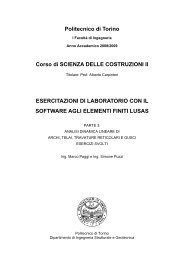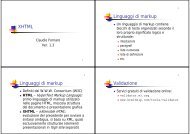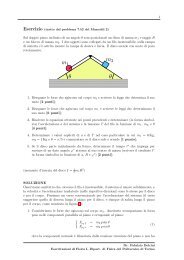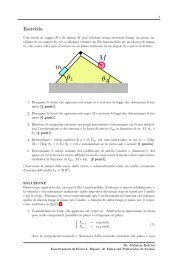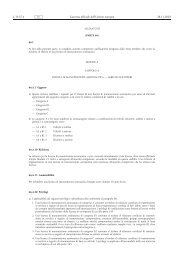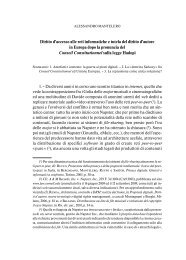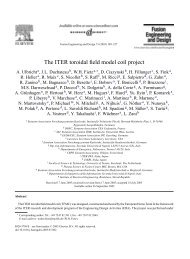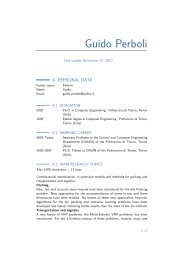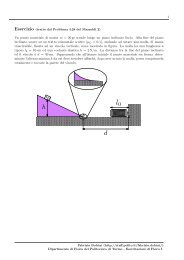The ThermoPower Library
The ThermoPower Library
The ThermoPower Library
You also want an ePaper? Increase the reach of your titles
YUMPU automatically turns print PDFs into web optimized ePapers that Google loves.
<strong>The</strong> <strong>The</strong>rmoPower <strong>Library</strong><br />
Francesco Casella<br />
(francesco.casella@polimi.it)<br />
Dipartimento di Elettronica e Informazione<br />
Politecnico di Milano
Power Plant Dynamic Modelling at DEI - Polimi<br />
1985-1993<br />
• LEGO simulation environment (developed by ENEL)<br />
– Modular modelling, solver for index-1 DAE's, models implemented in<br />
FORTRAN<br />
– Wide availability of tested models, very low flexibility and extensibility,<br />
extremely old-fashion development environment (native FORTRAN code)<br />
1993-2003<br />
• ProcSim simulation environment<br />
(Maffezzoni, Leva, Bartolini)<br />
– Modular modelling, specialized implicit Euler solver for thermo-hydraulic<br />
system equations, models implemented using LabVIEW<br />
– Very good run-time user interface, good avaliability of models, efficient, low<br />
flexibility and extensibility<br />
2003-<br />
• <strong>The</strong>rmoPower library, using Modelica<br />
(Casella, Leva)<br />
– Object-Oriented paradigm, using the Modelica language<br />
– Maximum flexibility and extensibility, growing model base, highly readable<br />
models<br />
2
Scope of the <strong>Library</strong><br />
Support for the generation of power plant models:<br />
– Modularity<br />
– Dynamic models<br />
– Degree of detail suited to system studies (not for component studies)<br />
• Non-linear, first-principles models<br />
• Lumped-parameter models<br />
• 1D Distributed parameter models<br />
• NO 3D CFD models<br />
Usage<br />
– Dynamic plant simulation<br />
– Computer-aided design of control strategies and controller architectures<br />
– Validation and tuning of control systems<br />
– Simulation study of large plant maneuvers (e.g. start-up)<br />
– Plant maneuver optimization<br />
Type of plants:<br />
– Traditional fossil-fired Rankine cycle<br />
– Gas Turbine plants<br />
– Combined cycles<br />
– Combined heat&power plants<br />
– Nuclear plants (gen III & IV)<br />
– Organic Rankine Cycle plants<br />
– Solar plants<br />
3
Issues with Object-Oriented Modelling of Power Plants<br />
• Some components have clearly defined interfaces (flanges, shafts, etc.)<br />
• Other components have a far less obvious structure<br />
Gas flow<br />
ISSUE #1: Abstract model structure<br />
(A)<br />
(B)<br />
/<br />
?<br />
<strong>The</strong> basic models must allow to describe<br />
complex heat transfer configurations<br />
4
Issues with Object-Oriented Modelling of Power Plants<br />
ISSUE #2: Many completely different models<br />
to describe the same physical object<br />
Liquid-filled pipe, with heat<br />
transfer through the lateral<br />
boundary<br />
• One-phase vs. Two-phase<br />
• Nature of the fluid<br />
• Radial velocity distributions<br />
• Compressibility and inertial effects<br />
• Pressure wave propagation<br />
• Discretization method for the PDE<br />
• Etc. etc. ...<br />
•<br />
It is hard to define standard o basic thermohydraulic<br />
models for general-purpose use<br />
5
Structure of the <strong>Library</strong> – I<br />
Problems with extensive use of inheritance<br />
– Difficult to define a hyerarchy of heterogeneous models<br />
– Modifying the “ancestor” equations can lead to hard-to-understand consequences on the<br />
“siblings”<br />
– <strong>The</strong> equations of a single model are scattered through many classes, thus hampering:<br />
• readability<br />
• modifiability / extensibility<br />
Judicious use of inheritance<br />
– Flat library structure<br />
– Inheritance is used to:<br />
• change the fluid property model<br />
• define families of very similar components (e.g. pumps, valves)<br />
• add advanced features to already functional components<br />
Modelling assumptions are selected through conditional equations, depending on<br />
boolean/integer parameters ⇒ low number of models with many options, e.g:<br />
– Options for the computation of the friction losses<br />
– Dynamic term in the momentum balance equation<br />
– Geometric characteristics<br />
– Type of initialization<br />
– ...<br />
6
Structure of the <strong>Library</strong> – II<br />
Type of fluids<br />
– Water / steam for the steam side of the generation processes<br />
(fluids other than water may be used)<br />
– Ideal gases (air, natural gases, flue gases etc.)<br />
Models of the same component (e.g. a valve) with different fluids<br />
– Choice 1:independent models<br />
– Choice 2: generic model + extensions with fluid-specific equations<br />
– Problem: changing the fluid, the modelling assumptions can vary drastically<br />
– <strong>The</strong> reuse of part of the equations actually make things more confusing<br />
• Two separate categories of models: water/steam and ideal gases<br />
• Within each family, the fluid model is replaceable<br />
7
Old Design of Flange Connectors (ver. 2.x)<br />
• <strong>The</strong>rmodynamic conditions are specified with a minimum number of non-redundant<br />
variables (Pressure, mass flow rate, specific enthalpy).<br />
• Maximum independence from how the internal equations of each component are<br />
written (encapsulation).<br />
• Support of reverse flow<br />
A B A B<br />
B A<br />
connector WaterFlangeB<br />
Pressure p;<br />
flow MassFlowRate w;<br />
output SpecificEnthalpy hBA;<br />
input SpecificEnthalpy hAB;<br />
end WaterFlangeB<br />
connector WaterFlangeA<br />
Pressure p;<br />
flow MassFlowRate w;<br />
input SpecificEnthalpy hBA;<br />
output SpecificEnthalpy hAB;<br />
end WaterFlangeA<br />
8
Using Flange Connectors: a Simple Example<br />
model SimpleMixer<br />
parameter Volume V=0 "Inner volume";<br />
FlangeA in;<br />
FlangeB out;<br />
Pressure p;<br />
Density rho;<br />
Mass M;<br />
Energy E;<br />
SpecificEnthalpy h,hi,ho;<br />
equation<br />
rho = rho_ph(p, h);<br />
M = V*rho;<br />
E = M*h – p*V;<br />
der(M) = in.w+out.w;<br />
der(E) = in.w*hi+out.w*ho;<br />
hi = if in.w >= 0 then in.hBA else h;<br />
ho = if out.w >= 0 then out.hAB else h;<br />
in.hAB = h;<br />
out.hBA = h;<br />
in.p = p;<br />
out.p = p;<br />
end SimpleMixer;<br />
hBA<br />
hAB<br />
in<br />
(FlangeA)<br />
hBA<br />
hAB<br />
out<br />
(FlangeB)<br />
9
DHT Connectors (Distributed Heat Transfer)<br />
Describe the heat transfer between distributed parameters models<br />
connector DHT;<br />
parameter Integer N=2 "Number of nodes";<br />
Temperature T[N];<br />
flow HeatFlux phi[N];<br />
end DHT;<br />
Extended DHT connector with heat transfer coefficient<br />
(computed internally based on the fluid conditions)<br />
connector DHThtc;<br />
extend DHT;<br />
CoefficientOfHeatTransfer gamma[N];<br />
end DHThtc;<br />
10
Computing the Fluid Properties: Modelica.Media<br />
<strong>The</strong> fluid properties are computed using the models contained in the standard<br />
Modelica.Media library. <strong>The</strong> fluid propery models and computational routines are<br />
contained in replaceable packages.<br />
Usage example::<br />
model Mixer<br />
replaceable package Medium = Modelica.Media.Interfaces.PartialMedium;<br />
Medium.BaseProperties fluid;<br />
...<br />
equation<br />
// <strong>The</strong> fluid properties are determined prescribing two thermodynamic<br />
// variables + the composition (for multiple-component fluids)<br />
// pressione, temperatura e composizione<br />
fluid.p = p;<br />
fluid.T = T;<br />
fluid.Xi = Xi;<br />
// all other base properties (u,d,T) are automatically computed by<br />
// the fluid model<br />
h = fluid.h;<br />
d = fluid.d;<br />
// it is also possible to compute additional fluid properties, using<br />
// the thermodynamic state vector contained in the fluid model<br />
lambda = Medium.thermalConductivity(fluid.state);<br />
...<br />
end Mixer;<br />
11
Computing the Fluid Properties: Modelica.Media<br />
• <strong>The</strong> models are written for a generic fluid (PartialMedium, or<br />
PartialTwoPhaseMedium);<br />
• When models are instantiated, it is possible to redeclare the medium package to<br />
specify the required fluid model (which extends PartialMedium or<br />
PartialTwoPhaseMedium)<br />
model Plant<br />
Mixer M1(redeclare package Medium = Modelica.Media.Air.MoistAir);<br />
Mixer M2(redeclare package Medium = Modelica.Media.IdealGases.FlueGas);<br />
...<br />
end Plant;<br />
• La standard Modelica.Media library contains several ready-to-use models<br />
– IAPWS IF97 water/steam properties<br />
– Accurate Ideal gas models (based on NASA data)<br />
– Humid air<br />
– Incompressible fluids, with table-based properties<br />
– ...<br />
• It is possible to develop new fluid models in Modelica (using the interfaces<br />
defined in Modelica.Media.Interfaces)<br />
• It is also possible to use FluidProp models, through the ExternalMedia interface.<br />
12
Features of <strong>The</strong>rmoPower ver. 3<br />
• Uses Modelica Standard <strong>Library</strong> 3.x<br />
• Standard Modelica.Fluid connectors are now used<br />
– same mathematical structure<br />
– no more complementary ports<br />
– compatible with Modelica.Fluid components<br />
• Homotopy operator used for more robust initialization<br />
– requires homotopy() support<br />
– if not available, dummy homotopy() function must be loaded<br />
• Not yet released officially (later this year)<br />
• Development version available on SVN (anonymous read-only checkout):<br />
https://thermopower.svn.sourceforge.net/svnroot/thermopower/trunk<br />
13
Gas flow<br />
Complex Heat Transfer Configurations<br />
Complex configurations like the one shown here can be modelled.<br />
<strong>The</strong> modeller must write specific code for the heat transfer module. <strong>The</strong> wall models<br />
and the Flow1D models are taken straight from the library<br />
(A)<br />
(B)<br />
(Wall B)<br />
(Heat Transfer<br />
Module)<br />
(Wall A)<br />
(Fluid B)<br />
(Fluid A)<br />
(Gas Flow)<br />
14
Applications of the <strong>The</strong>rmoPower library<br />
15
CISE<br />
16
CISE<br />
• First real-life application<br />
• Simulation of a lab model of a<br />
steam generator (100 kW,<br />
electrically powered)<br />
• Available data:<br />
– Dimensional data<br />
– Open-loop transient recordings<br />
• Medium complexity, in terms of<br />
number of components<br />
• Maximum achievable degree of<br />
detail of the single components<br />
17
CISE<br />
• Model diagram<br />
• Complexity (after the symbolic<br />
manipulation phase):<br />
– 50 states<br />
– 300 algebraic variables<br />
18
CISE - Validation<br />
• Pressure: 60 bar<br />
• Step reduction of the power to the evaporators<br />
19
CISE - Validazione<br />
• Pressure: 60 bar<br />
• Step reduction of the power to the evaporators<br />
20
CISE - Validazione<br />
• Pressure: 30 bar<br />
• Step increase in the steam valve opening<br />
21
CISE - Validazione<br />
• Pressure: 60 bar<br />
• Step increase in the steam valve opening<br />
22
IRIS<br />
23
IRIS<br />
• First industrial application: IRIS consortium (PoliMi +<br />
Westinghouse + others)<br />
• Study of the control system for a new generation PWR<br />
nuclear plant<br />
• “Lightweight” models needed to support the control<br />
design activities<br />
• Integration of the <strong>The</strong>rmoPower and NuKomp libraries<br />
for the modelling of the nuclear core (Fourier<br />
equations for the fuel rods + point neutronic kinetics)<br />
• Set up of a family of consistent plant models<br />
– Accurate reference model, to be compared with<br />
detailed simulation code results (RELAP)<br />
– More/less detailed control system models<br />
– More/less detailed turbine + feedwater train<br />
models<br />
– More/less detailed models of the steam generator<br />
– Modelli for very fast simulations<br />
24
IRIS<br />
• Base model: four empty units (partial models) connected together.<br />
• Actual simulators are obtained by instantiating the base model and replacing the<br />
units with one of their available implementations<br />
25
IRIS<br />
• NSSS diagram<br />
Replaceable models<br />
26
IRIS<br />
Core diagram:<br />
Integration of <strong>The</strong>rmoPower and<br />
NuKomp components<br />
27
IRIS<br />
• “<strong>Library</strong> of simulators”<br />
– Interface (empty shell with connectors)<br />
for each unit<br />
– Many implementation for each unit<br />
– Common repository of geometric and<br />
design data<br />
– Replaceable fluid models<br />
• Instantiation of a specific simulator<br />
– A' la carte choice of details<br />
model IRISSimulator_V2<br />
extends IRISSimulatorBase(<br />
redeclare Plants.NSSS_V1 NSSS(<br />
redeclare package PrimaryMedium =<br />
Media.SimpleIncompressibleWater,<br />
Core(N = 7),<br />
redeclare Plants.HelicalCoilFVChen<br />
HelicalCoil(N=15)),<br />
redeclare Controls.CS_V2 CS,<br />
redeclare Controls.SS_V2 SS,<br />
redeclare Plants.TGFWS_V1 TGFWS);<br />
end IRISSimulator_V2;<br />
• All the implementable simulators are<br />
consistent by design!<br />
28
IRIS – Validation vs. RELAP code<br />
• <strong>The</strong> model has been validated in open loop agains results obtained from a RELAP<br />
model (good for accident simulation and safety analysis, but very slow)<br />
29
IRIS – Test of Closed-Loop transients<br />
• Simulazions carried out with a<br />
simplified model of the digital<br />
control system (5 main control<br />
loops)<br />
• In the future: multi-mode<br />
controller, including start-up and<br />
shut-down<br />
• Using an incompressible fluid<br />
model for the primary loop, a<br />
non-stiff model is obtained<br />
• This can be simulated using a<br />
fixed-time-step forward Euler<br />
algorithm, resulting in 20X realtime<br />
simulation speed.<br />
30
FLUE-GAS PATH<br />
SIMULATOR<br />
31
Flue-Gas Path Simulator<br />
• Study of the pressure control system in the flue gas circuit for a revamped coalfired<br />
power plant<br />
– SCR unit<br />
– De-NOx unit<br />
– De-SOx unit<br />
– Booster fan<br />
• A CFD study was available for some selected static operating conditions; it was<br />
then necessary to check if the control system can carry out all the foreseen<br />
maneuvers without tripping the plant:<br />
– Load level increase / decrease due to dispatching<br />
– Insertion / Exclusion of the De-SOx unit<br />
– Fan unit trip<br />
• Highlights:<br />
– Ad-hoc con know-how proprietario (operating curves)<br />
– Very detailed modelling of the logic control system<br />
32
Flue-Gas Path Simulator<br />
• Plant model: high-level diagram<br />
33
Flue-Gas Path Simulator<br />
• Model of a fan unit<br />
34
Flue-Gas Path Simulator<br />
• Control system block diagrams<br />
• Each logic blocks is specified through an algorithm<br />
Furnace pressure control Bypass insertion sequencer<br />
35
CESI - CC<br />
36
CESI - CC<br />
• Development of a dynamic model for a typical Combined-Cycle unit, to study fast<br />
start-up strategies<br />
• <strong>The</strong> model includes the computation of the thermal stresses in the most critical<br />
points of the plant (steam turbine shaft)<br />
• <strong>The</strong> control strategy must be selected in order to minimize the start-up time (from<br />
shut-down plant up to full load), without exceeding the maximum allowed stress<br />
levels.<br />
• <strong>The</strong> strategies have been determined by trial-and-error. In the future, the model<br />
could be coupled to an optimization software, to compute the optimal control<br />
signals automatically<br />
• Also, simplified versions of the model could be used to build model-based<br />
controllers (e.g. predictive controllers)<br />
• Highlights:<br />
– High complexity (large number of componentsi)<br />
– Start-up conditions included (low or zero flow rates, very low pressures, etc.)<br />
37
CESI - CC<br />
• High-level structure of the plant simulator<br />
38
CESI - CC<br />
• Heat recovery boiler model<br />
39
CESI - CC<br />
• Steam turbine unit model<br />
40
CESI - CC<br />
• Low-level controllers<br />
41
CESI – CC: Simulation Results<br />
• Reference start-up transient: steam flow rates<br />
42
CESI – CC: Simulation Results<br />
• Reference start-up transient: steam and HP turbine rotor temperatures<br />
43
CESI – CC: Simulation Results<br />
• Reference start-up transient: thermal stresses on HP and MP turbine rotors<br />
44
CESI – CC: Simulation Results<br />
• Minimum-time start-up transient:: thermal stresses on HP and MP turbine rotors<br />
45
Modelling of Combined-Cycle Power Plants<br />
• Circulation type for evaporators<br />
– forced circulation<br />
– natural circulation<br />
– once-through (seldom used)<br />
• Cycle configuration<br />
– two pressure levels no reheat<br />
– three pressure levels w/ reheat<br />
• Steam turbine configuration<br />
– Arrangement of HP/IP/LP stages<br />
– Single- or double-flow<br />
• Plant configuration<br />
– Single shaft (1 GT/HRSG, 1 ST on same generator shaft)<br />
– Double shaft (1 GT/HRSG, 1 ST on separate generator shafts)<br />
– Triple shaft (2 GT/HRSG, 1 ST, three generator shafts)<br />
– …<br />
• Goal of the PowerPlants package in <strong>The</strong>rmoPower:<br />
– provide abstract interfaces for all these categories<br />
– provide template pre-built models for at least some cases<br />
– avoid repetitive and tedious work when setting up a new model<br />
46
Heat exchanger unit<br />
• Interface has 4 connectors<br />
• Different implementations using<br />
basic components from the library<br />
– 1 phase / 2 phase<br />
– heat transfer phenomena<br />
• fixed/varying h.t.c.<br />
• convection<br />
• radiation<br />
• ad-hoc correlations<br />
47
Heat Recovery Steam Generator body<br />
• Two or three levels of<br />
pressure<br />
• Two interfaces<br />
defined accordingly<br />
48
Heat Recover Steam Generator body<br />
• Example implementation of two-levels of pressure HRSG<br />
49
Drum units<br />
• Two and three levels of<br />
pressure interfaces<br />
• Different implementations<br />
– natural circulation (no pumps)<br />
– forced circulation (w/ pumps)<br />
50
Complete HRSG unit<br />
• Interfaces defined for two and<br />
three levels of pressure<br />
• Example implementations built with HRSG<br />
body and drum units<br />
51
Steam turbine unit<br />
• Interfaces for<br />
– two levels of pressure, no reheat<br />
– three levels of pressure w/ reheat<br />
• Different implementations<br />
– simpler model for normal<br />
operation only<br />
– complete model including<br />
bypass paths for start-up<br />
simulation<br />
52
Complete plant model<br />
• Using the unit models defined before, one can easily assemble a complete<br />
plant model with any specific configuration<br />
53
References<br />
• <strong>The</strong>rmoPower library Home page http://home.dei.polimi.it/casella/thermopower/<br />
• A. Leva, C. Maffezzoni: “Modelling of power plants”, <strong>The</strong>rmal power plant simulation and<br />
control, D. Flynn (Ed.), IEE, London, pp. 17–60, 2003.<br />
• F. Casella, A. Leva: “Modelica open library for power plant simulation: design and<br />
experimental validation”, Proc. Modelica Conference 2003, Linköping, Sweden, 2003.<br />
F. Casella, A. Leva: “Modelling of thermo-hydraulic power generation processes using<br />
Modelica”, Mathematical and Computer Modelling of Dynamical Systems, Vol. 12, No. 1,<br />
February 2006, 19 – 33, 2006<br />
• Francesco Casella and Alberto Leva, “Modelling of <strong>The</strong>rmo-Hydraulic Power Generation<br />
Processes Using Modelica”. Mathematical and Computer Modeling of Dynamical Systems,<br />
vol. 12, n. 1, pp. 19-33, Feb. 2006.<br />
• Antonio Cammi, Francesco Casella, Marco Ricotti and Francesco Schiavo, “Object-Oriented<br />
Modeling, Simulation and Control of the IRIS Nuclear Power Plant with Modelica”. In<br />
Proceedings 4th International Modelica Conference, Hamburg, Germany, Mar. 7-8, 2005, pp.<br />
423-432.<br />
• Francesco Casella and Francesco Pretolani, “Fast Start-up of a Combined-Cycle Power<br />
Plant: a Simulation Study with Modelica”. In Proceedings 5th International Modelica<br />
Conference, Vienna, Austria, Sep. 6-8, 2006, pp. 3-10.<br />
• Andrea Bartolini, Francesco Casella, Alberto Leva and Valeria Motterle, “A Simulation Study<br />
of the Flue Gas Path Control System in a Coal-Fired Power Plant”. In Proceedings ANIPLA<br />
International Congress 2006, Rome, Italy, Nov. 13-15, 2006.<br />
• Francesco Casella, “Object-Oriented Modelling of Power Plants: a Structured Approach”. In<br />
Proceedings of the IFAC Symposium on Power Plants and Power Systems Control, Tampere,<br />
Finland, July 5-8, 2009.<br />
54



